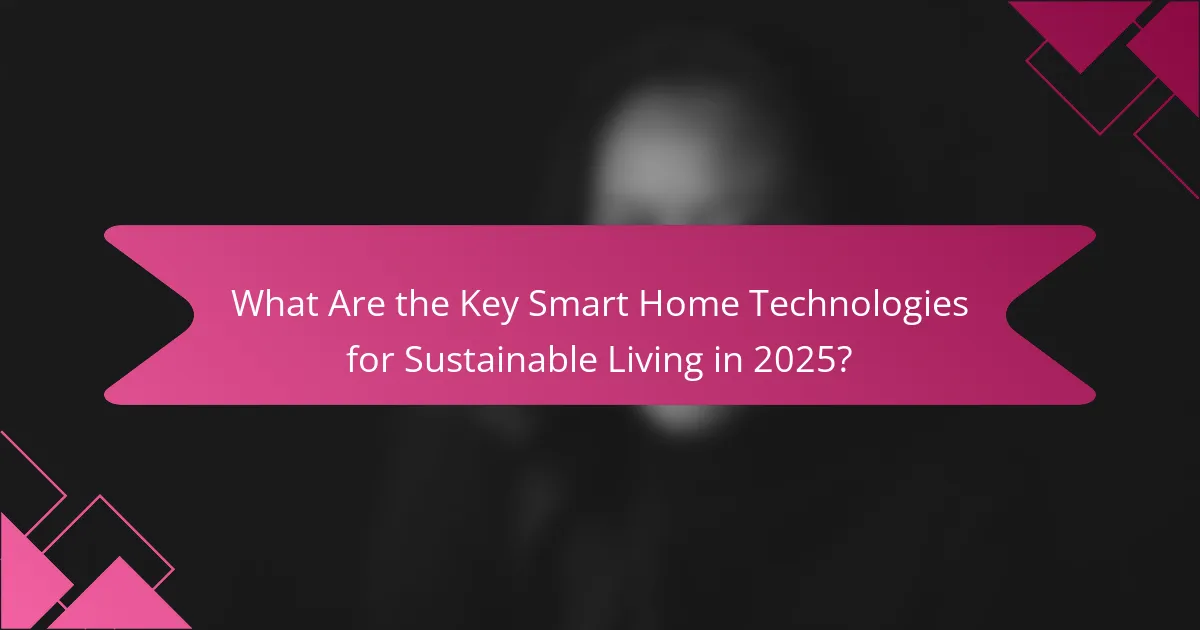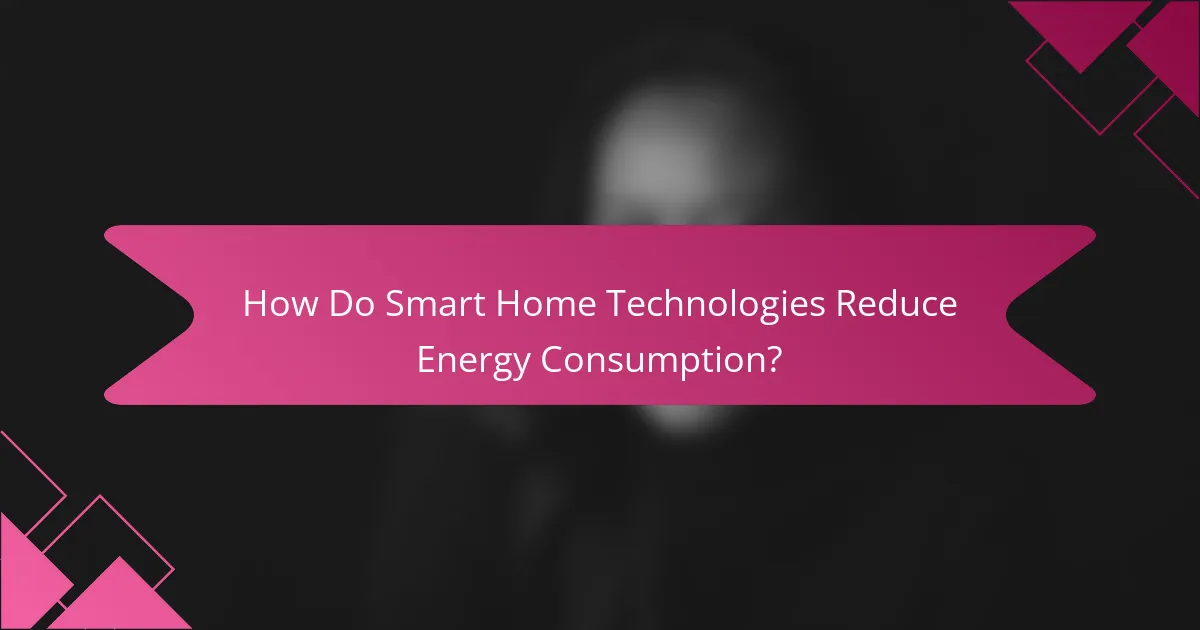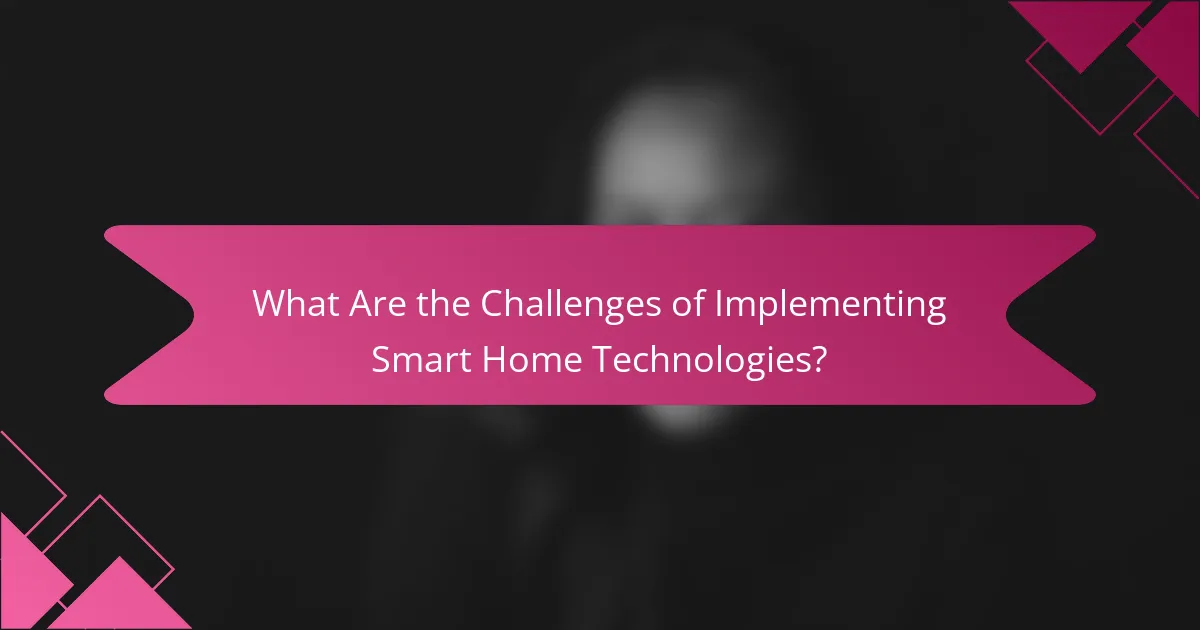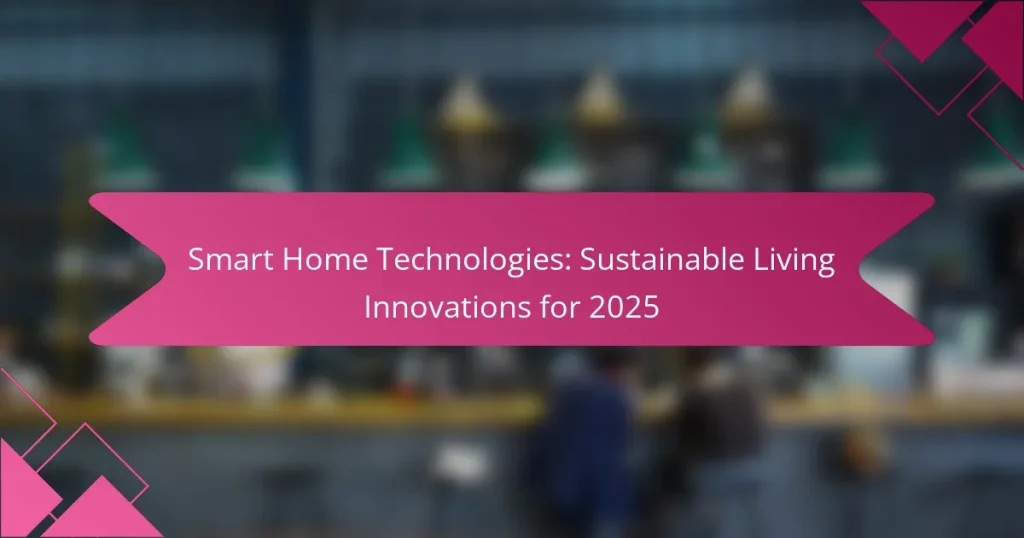As we approach 2025, smart home technologies are poised to revolutionize sustainable living by enhancing energy efficiency and promoting renewable energy use. These innovations not only help homeowners save on utility bills but also significantly reduce their carbon footprint. By leveraging real-time data and automation, these systems empower individuals to manage their energy consumption more effectively, leading to a more environmentally friendly lifestyle.

What Are the Key Smart Home Technologies for Sustainable Living in 2025?
Key smart home technologies for sustainable living in 2025 include systems that enhance energy efficiency, reduce waste, and promote renewable energy use. These innovations not only lower utility bills but also contribute to a more environmentally friendly lifestyle.
Smart Thermostats
Smart thermostats optimize heating and cooling by learning user preferences and adjusting settings automatically. They can significantly reduce energy consumption, often by around 10-15%, by ensuring that heating or cooling only occurs when necessary.
When selecting a smart thermostat, consider compatibility with your HVAC system and features like remote access and energy usage reports. Popular models include the Nest Learning Thermostat and the Ecobee SmartThermostat.
Energy-Efficient Appliances
Energy-efficient appliances are designed to use less electricity and water while maintaining performance. Look for products with the ENERGY STAR label, which indicates compliance with strict efficiency guidelines.
Examples include refrigerators, washing machines, and dishwashers that consume up to 50% less energy than standard models. Investing in these appliances can lead to substantial savings on utility bills over time.
Solar-Powered Systems
Solar-powered systems harness renewable energy from the sun, significantly reducing reliance on fossil fuels. Homeowners can install solar panels to generate electricity, which can cover a substantial portion of their energy needs.
Consider local incentives, such as tax credits or rebates, which can offset installation costs. Many systems can pay for themselves within 5-10 years through energy savings and government programs.
Smart Lighting Solutions
Smart lighting solutions allow users to control their home lighting remotely and set schedules to minimize energy use. LED bulbs paired with smart technology can reduce energy consumption by up to 80% compared to traditional incandescent bulbs.
Features to look for include dimming capabilities, color temperature adjustments, and integration with home automation systems. Popular products include Philips Hue and LIFX smart bulbs.
Home Automation Platforms
Home automation platforms integrate various smart devices into a cohesive system, allowing for centralized control and automation of tasks. These platforms can enhance energy efficiency by coordinating devices to work together, such as adjusting thermostats and lighting based on occupancy.
When choosing a platform, consider compatibility with existing devices and ease of use. Popular options include Google Home, Amazon Alexa, and Apple HomeKit, each offering unique features and integrations.

How Do Smart Home Technologies Reduce Energy Consumption?
Smart home technologies significantly reduce energy consumption by optimizing energy use through real-time data and automation. These systems enable homeowners to monitor and manage their energy consumption more effectively, leading to lower utility bills and a smaller carbon footprint.
Real-Time Energy Monitoring
Real-time energy monitoring allows homeowners to track their energy usage as it happens. By using smart meters and energy monitoring devices, individuals can identify which appliances consume the most power and adjust their habits accordingly.
For example, a smart home system can provide insights into energy usage patterns, helping users to pinpoint peak consumption times. This awareness can lead to behavioral changes, such as running high-energy appliances during off-peak hours to save on costs.
Automated Energy Management
Automated energy management systems use algorithms to optimize energy consumption based on real-time data. These systems can automatically adjust heating, cooling, and lighting based on occupancy and time of day, ensuring energy is used only when needed.
For instance, smart thermostats can learn a homeowner’s schedule and adjust temperatures accordingly, potentially reducing heating and cooling costs by 10-20%. Users should consider integrating these systems with their existing appliances for maximum efficiency.
Integration with Renewable Energy Sources
Integrating smart home technologies with renewable energy sources, such as solar panels, enhances energy efficiency. Homeowners can monitor solar energy production and consumption in real-time, allowing them to use renewable energy when it is most abundant.
For example, a smart home system can prioritize using solar energy for high-demand appliances during peak sunlight hours. This not only reduces reliance on the grid but can also lead to significant savings on energy bills, especially in regions with favorable solar incentives.

What Are the Benefits of Smart Home Innovations?
Smart home innovations offer numerous benefits, including cost savings, enhanced comfort, and reduced environmental impact. These technologies integrate seamlessly into daily life, improving efficiency and sustainability in homes.
Cost Savings on Utility Bills
Implementing smart home technologies can lead to significant cost savings on utility bills. Smart thermostats, for example, can reduce heating and cooling costs by optimizing energy use based on occupancy and preferences.
Homeowners can save anywhere from 10% to 30% on their energy bills by using smart devices that monitor and control energy consumption. Additionally, smart lighting systems can automatically turn off when rooms are unoccupied, further reducing electricity costs.
Enhanced Comfort and Convenience
Smart home innovations greatly enhance comfort and convenience for residents. Automated systems allow users to control lighting, temperature, and security from their smartphones or through voice commands, making daily routines more efficient.
For instance, smart speakers can manage home devices, play music, or provide reminders, creating a more personalized living experience. Furthermore, smart appliances can notify users when tasks are complete, such as laundry or cooking, adding to overall convenience.
Environmental Impact Reduction
Smart home technologies contribute to environmental impact reduction by promoting energy efficiency and resource conservation. Devices like smart thermostats and energy monitors help users track and reduce their energy consumption, which can lead to a lower carbon footprint.
Moreover, smart irrigation systems optimize water usage for gardens and lawns, ensuring that plants receive the right amount of water without waste. This not only conserves water but also supports sustainable landscaping practices.

What Are the Challenges of Implementing Smart Home Technologies?
Implementing smart home technologies presents several challenges that can hinder their adoption. Key issues include high initial costs, privacy and security concerns, and compatibility issues among devices.
High Initial Costs
The initial investment for smart home technologies can be significant, often ranging from hundreds to thousands of dollars depending on the complexity of the system. This includes costs for devices, installation, and potential upgrades to existing infrastructure.
Homeowners should consider the long-term savings on energy bills and increased property value when evaluating these costs. However, financing options and rebates may be available to help offset the upfront expenses.
Privacy and Security Concerns
Smart home devices can pose privacy and security risks, as they often collect and transmit personal data. Users must be cautious about the information shared with these devices and the potential for unauthorized access.
To mitigate these risks, it’s essential to use strong, unique passwords and regularly update device firmware. Additionally, consider devices that comply with recognized security standards to enhance protection.
Compatibility Issues
Compatibility among different smart home devices can be a significant hurdle. Not all devices work seamlessly with each other, which can lead to a fragmented user experience and increased frustration.
Before purchasing, homeowners should verify that devices are compatible with their existing systems or platforms, such as Google Home or Amazon Alexa. Researching brands that prioritize interoperability can also simplify integration efforts.

How to Choose the Right Smart Home Solutions?
Choosing the right smart home solutions involves assessing your specific needs, budget, and the compatibility of devices. Focus on energy efficiency, ease of use, and the ability to integrate with existing systems for a sustainable living environment.
Assessing Energy Needs
Start by evaluating your current energy consumption patterns to identify areas where smart technology can make a difference. Consider factors such as the size of your home, the number of occupants, and the types of appliances you use.
Look for smart home devices that offer energy monitoring features. These devices can help you track usage in real-time and provide insights on how to reduce consumption, potentially saving you tens of percent on your energy bills.
When selecting solutions, prioritize those that are compatible with renewable energy sources, such as solar panels. This alignment can enhance your sustainability efforts and may qualify you for local incentives or rebates, depending on your region.

